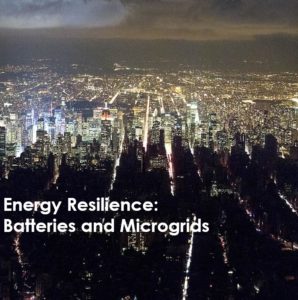Energy Resiliency in Santa Monica
 I was pleased to be part of another successful Solar Santa Monica event. EcoMotion has run the Solar Santa Monica program for ten years, and now we’re pushing into new waters… specifically the nexus between solar power, climate protection, and energy resilience. Santa Monica has appointed its first Chief Resiliency Officer (CRO). Pretty cool.
I was pleased to be part of another successful Solar Santa Monica event. EcoMotion has run the Solar Santa Monica program for ten years, and now we’re pushing into new waters… specifically the nexus between solar power, climate protection, and energy resilience. Santa Monica has appointed its first Chief Resiliency Officer (CRO). Pretty cool.
Drew Lowell-Britt from my staff had taken the lead organizing the event. He’d invited vendors to table, established an Eventbrite invitation plus a social media strategy, and prepared and sent blasts within Santa Monica. Quickly the late morning event was gaining attention. This next evolution in the solar + storage paradigm is of great interest.
Humbled I was by the caliber of the registrants. Battery providers including Sonnen and STEM wanted to participate; XERO Solar and PermaCity Solar were on hand. The meeting/town hall was held at Santa Monica’s impressive City Library. Interested citizens began to fill the MLK Auditorium. My job was to educate and enthuse. No pressure!
Many solar system owners assume that when the grid goes down, they will have power. Not true in almost all cases. To become resilient to outages, I explained that you need some form of generation, plus storage and controls. The 40-minute talk focused on today’s potential in Santa Monica for energy resiliency thanks to abundant sunshine, a new class of batteries, and sophisticated microgrids.
Microgrids are not a new concept, nor are they necessarily carbon free. I began with a slide of Thomas Edison’s first power plant, the Pearl Street station, a coal-power microgrid that served 400 lamps! I presented Co-op City in the Bronx, and the Stone Edge Farm microgrid project in Sonoma, California. I presented hybrid-electric buildings made possible by advanced energy storage and the lithium-ion revolution. I juxtaposed the current energy storage revenue models being promoted by STEM, GreenCharge Network, Advanced Microgrid Solutions, and others with the notion of energy resilience through back-up.
Then I shifted to the EcoMotion resiliency model, our works developing PERCs at twelve school sites in Monterey and Santa Clara counties. These Powered Emergency Response Centers are being enabled thanks to solar plus storage plus sophisticated microgrid controls. During prolonged grid outages, these campuses will be powered indefinitely by the sun. For one district, 100% solar plus 7-hour storage will be delivered at parity to what the district is currently paying. Both districts are using innovative financing to get the job done and to get unusually high levels of resilience.
We had a mix of people in the audience, from school district officials, to businesses, architects, city officials, and residents. My talk wrapped with a focus on “your home” and how to make it a carbon-free microgrid and energy resilient in nine steps. Yes, you will need to first maximize your energy efficiency. Next it’s time to size storage for planned electric loads like EVs and heat pumps. Then you’ll have to determine what level of back-up you desire and can afford.
Perhaps most importantly, let’s be clear: While there are ways to buy batteries and to flex them for profit, if your goal is resiliency… get real and give up notions of payback and returns. Those are very secondary to the mission at hand. Energy resilience is about being prepared. Keeping kids in school; making your home viable. It is insurance, it is peace of mind… far from the demand-clipping revenue models being promoted by most storage companies today. This is a new model, and one that is gaining attention.
